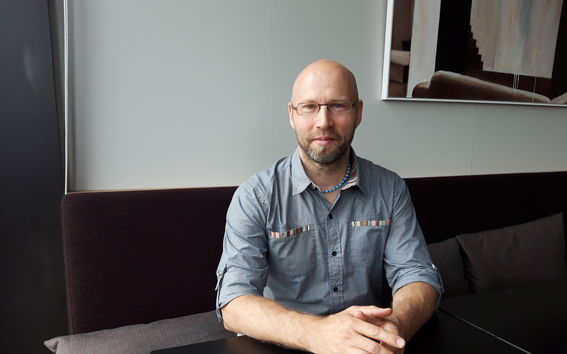Panu Erästö has digitalised studying on basic courses of statistics

University lecturer Panu Erästö works in subjects involving quantitative methods at the Department of Information and Service Management of the School of Business. He mainly teaches mandatory courses with several hundred students attending. According to Panu Erästö, the digitalisation of teaching has been an absolute necessity owing to both huge numbers of students, as well as the fact that teacher resources and facilities are in shorter supply than before. Today’s students are mainly well oriented to digital learning, but there are some challenges as well. Without technology, the giving of feedback would also inevitably be quite meagre in mass courses.
Panu Erästö specialises specifically in blended learning in mathematical courses. In other words, study habits include both instruction that takes place in a lecture hall and independent study made possible by technology.
‘On the basis of the feedback my teaching methods have been received favourably by the students. Naturally, a few years ago, there was initial resistance owing to the change in culture and working methods, but gradually students got used to it. At present, students see automated exercises mostly as very positive and educational. At the same time, they need to practice taking responsibility for their own learning,’ Erästö tells.
Multiple choice exercises, gamification, and teaching videos
‘I have given many "quiz" type exercises containing multiple choice, combination exercises as well as numerical problems, of which a significant portion are personalised exercises. When doing these exercises a student receives immediate and automatic feedback with explanations on whether or not the exercise was done correctly. It is also possible to get hints and a step-by-step model solution to the tasks. When the feedback is immediate, learning is significantly better,’ Panu Erästö tells about his teaching philosophy.
He has gamified both basic level courses and more advanced ones.
‘As with games, there are levels in exercises where different tasks are resolved in each, which can also be reviewed before moving to the next step. Learning is better when things are offered step by step.’
‘Exams are also fully electronic, and the results are available immediately. Students who initially give a wrong answer in a test can try again according to the hints given by the programme. Students who manage to give a correct answer after getting a hint get partial points for the solution. This means that it is still possible to learn during a test.’
In addition to quizzes Panu Erästö has produced several educational videos for his courses showing, for instance, how Excel can be used for calculating various basic exercises in mathematics and statistics and for drawing graphs. On the video, I show in detail how Excel works. This also frees up time in the actual lectures for other things. Students seem to like the videos very much because they can be watch them at home as many times as is felt necessary, and they can revisit them as well.
Digitalisation of exercises: time-consuming but rewarding
According to Panu Erästö, the building and maintenance of an electronic system takes very much time, but it also makes learning worthwhile and is the only option in light of the resources available.
‘In the first year much time was spent on making videos, but now it's starting to pay off. Starting small is worthwhile.’
Panu Erästö himself has been responsible for the development of the automatisation of exercises, and this has been pioneer work by its nature – in the beginning I had no references that I could have used as a model.
‘So that nobody would need to re-invent the wheel, I have shared my knowledge, experience, and practice in Aalto. Aalto Online Learning (A!OLE) has granted me funding for hiring assistants, which has certainly been valuable to plan and implement courses.’
More about A!OLE: https://onlinelearning.aalto.fi/
Text: Terhi Ollikainen
N.B.
- Aalto Online Learning calling for new idea proposals – DL 21.8. at noon!
Aalto Online Learning, a strategic educational development project, is calling for ideas on online and blended learning. All Aalto people from any field of study are invited to suggest ideas for advancing online learning at Aalto University. We offer support and funding for a variety of ideas related to online and blended learning. Projects can range from developing courses or majors, to creating pedagogical trainings or exploring digital services for learning. https://onlinelearning.aalto.fi/blog/news/5113-autumn-2019-call-for-idea-proposals-now-open
- Aalto Online Learning Call for Idea Proposals Clinic 13.8. at 10, Johanna Learning Centre
Need help with getting prepared for the Aalto Online Learning Call for Idea Proposals? Want advice on filling in the Call for Idea Proposals form? Not sure whether to propose an idea or not? Join us in our Call for Idea Proposals clinic and get answers to your questions! No need to sign up, this is an open walk-in event. https://onlinelearning.aalto.fi/events/call-for-idea-proposals-clinic-2019-08-13
- Published:
- Updated:
Read more news

5 ways to train your creativity this Spring and Summer
To celebrate the United Nations World Creativity Day on April 21, we made a list of five tips to boost your creativity this Spring/Summer
A new way to do controlled experiments in medicine: simulate the control
Generative AI could augment randomized controlled trials.
Designs created by aaltonians on display at the Milan furniture fair
An Italian designer and a Japanese architect are presenting their collaboration, inspired by the Finnish culture, at the "Salone del Mobile" in Milan in April. Other design projects from Aalto are on display at the INTERDEPENDENCE exhibition.